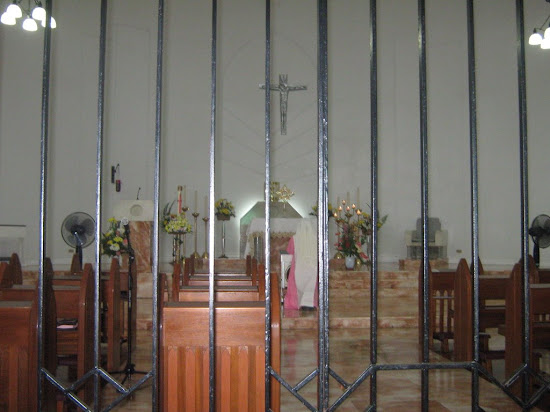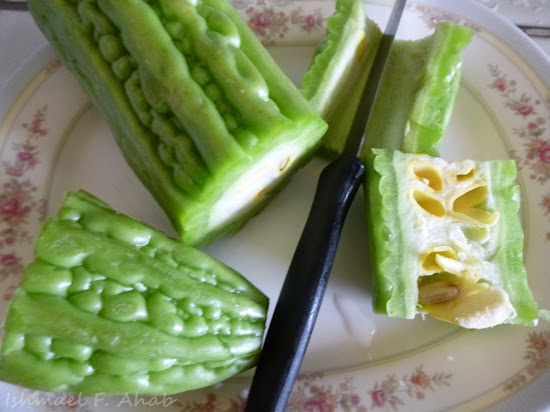I noticed that many people are interested with the Pink Sisters of Tagaytay City. Many of the visitors on my post,
A Visit to Pink Sisters' Convent, asked about the mass schedules, contact information, address and even about the requirements for being a Pink Sister.
I made this post to serve as a FAQ page for those who are looking for information about the Pink Sisters in Tagaytay City.
.
A Little Information about the Pink Sisters
The Pink Sisters are officially known as the Holy Spirit Adoration Sisters. Their community was established by St. Arnold Janssen together with Mother Maria Michael and Blessed Maria Virgo on 1896 in Holland.* They are fondly called as the Pink Sisters because of their rose-colored habit, which they wear to honor the Holy Spirit.
The Pink Sisters first came to the Philippines via the invitation Bishop Alfredo Versoza, who is considered as the first Filipino bishop of Lipa.** “10 pioneer sisters, 5 Germans and 5 Americans from Philadelphia, arrived in Manila in 1923.”*** They stayed in the convent of the “Blue Sisters” (Missionary Sisters Servants of the Holy Spirit), who are their “sister order”, before going to their convent in Lipa, Batangas.
The hot and humid weather of Batangas didn't suit the Pink Sisters and many of them got sick. Because of this, the Pink Sisters were transferred to Baguio City. Their convent in the Summer Capital of the Philippines is now one of the many convents of the Pink Sisters in the country.
Other Convents of the Pink Sisters
The Convent of Divine Mercy in Tagaytay is only one of 6 convents of Pink Sisters in the Philippines. So, if you are seeking for prayers from the Pink Sisters for your spiritual and temporal needs then you might not need to go to Tagaytay.
.
You can find Pink Sisters' convents in Baguio City, Quezon City, Mandaue City, Davao City, and Kalibo (Aklan). You can see the complete address of the convents at the
Pink Sisters' website.
Pink Sisters' Tagaytay Convent Contact Info
 |
| Divine Mercy Convent. |
For those who want to send letters or packages to the Pink Sisters in Tagaytay, you can use this address:
P.O. Box # 08, Holy Spirit Drive,
Brgy. Maitim 2nd, East
4120 Tagaytay City
Unfortunately, the telephone number shown on the Pink Sisters website is wrong according to some commenters to my previous blog post. Other telephone numbers that I found in the Internet were also said to be wrong. It is possible that the sisters had their telephone line cut off. So, if you intend to communicate with the Pink Sisters it is better for you to drop by their convent and talk to them personally.
How to Go to Pink Sisters' Convent in Tagaytay
Going to the Divine Mercy Convent is easy and it is just around 300 meters from the E. Aguinaldo Highway at the end of Holy Spirit Drive, which in Bing Map is named as Arnoldus Road.
.
 |
| Bing map showing the location of Divine Mercy Convent. |
If you are driving from the north, just follow E. Aguinaldo Highway until you see the signage of the Holy Spirit Adoration Sisters to your left. Turn left to Holy Spirit Drive until you reach the convent at the end of the road.
Those who are commuting from Manila or other Cavite provinces located north of Tagaytay should board a bus going to Tagaytay or Nasugbu. Go down at the place where you saw the signage of Holy Spirit Adoration Sisters located to your left. Just walk along the Holy Spirit Drive until you reach the convent at the end of the road.
.
 |
| The gate of Divine Mercy Convent. |
Take note that buses, trucks, coasters, jeeps, tricycles and motorcycles are not allowed inside the convent grounds.
Things to Do Inside Pink Sisters' Convent
One thing to keep in mind when entering the Pink Sisters' Convent in Tagaytay is that it is a holy place. The sisters live a life of silence and contemplation and it is disrespectful if you are noisy or cause disturbance. You should also wear modest clothing.
The Divine Mercy Convent is not a park so don't act like a tourist in this place. With these reminders said, here are the things that you can do once you're inside Pink Sisters' Convent.
1. Pray
Silence fosters prayer and allow us to meditate deeply. The Divine Mercy Convent is a good place for prayer. Another plus is that you are praying in front of the Most Holy Eucharist. Thus, you are praying directly to Jesus Christ when you pray inside this convent.
Another reason why many people flock to Pink Sisters' convent is that many people say that their prayers were answered after they prayed with the Pink Sisters. One commenter on my previous post said that his petitions were answered after going to a mass in the Divine Mercy Convent.
2. Attend Mass
Divine Mercy Convent has daily masses and Sunday masses. Here is the of the masses according to
Pink Sisters' website****:
Daily masses: 6:30 a.m.
Daily vespers or benediction: 5:00 p.m.
Sunday mass: 7:30 a.m. and 5:00 p.m. (with Vespers)
First Saturday mass: 4:15 p.m
3. Buy Yummy Treats
Anney, a fellow blogger, commented that Pink Sisters make delicious cookies. My brother also said that their buko pie is also delicious. I failed to buy those yummy treats when I visited their convent. :-(
If you're going to the Pink Sisters' convent in Tagaytay, I suggest that you buy some of their yummy treats. You will definitely enjoy eating it while you support the sisters financially.
4. Give Your Prayer Intentions
One of thing that I did when I visited the Pink Sisters' convent is to leave my prayer petitions to them. I believe that the sisters were praying for my intentions in front of the Holy Eucharist.
There are papers and pens that are ready to be used by visitors who want to commend their intentions to the sisters. Just write your prayer intentions and drop it to the designated drop boxes.
So, I think that I already provided most of the questions that are being asked about the Pink Sisters' convent in Tagaytay. Hope I helped you with the information I posted here. Please don't hesitate to leave a comment if you still have questions.
---
Information for these post was gathered from the following websites:
Refresh Post is a monthly segment that aims to take another look at the old topics posted on this blog.












































